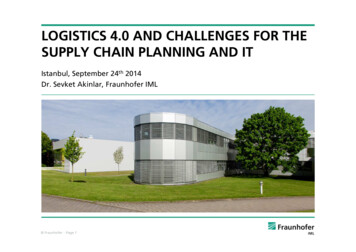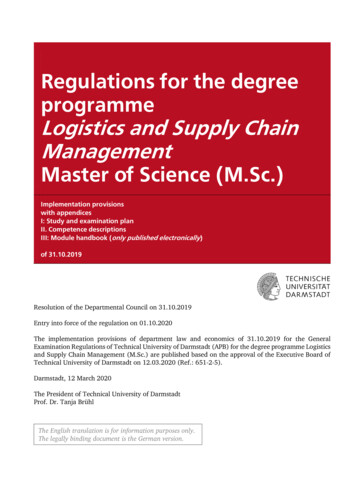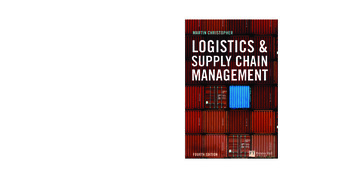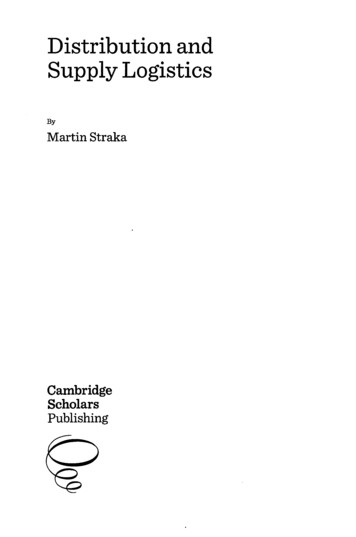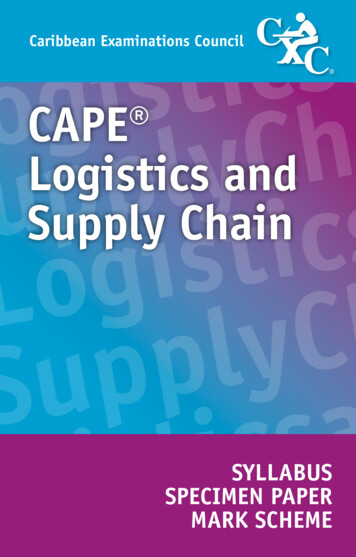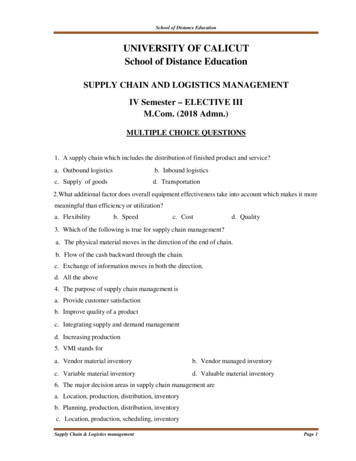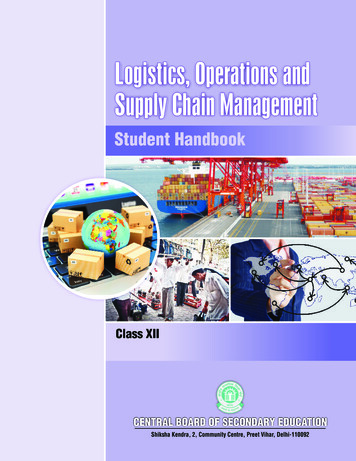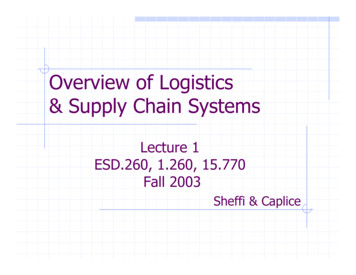
Transcription
Overview of Logistics& Supply Chain SystemsLecture 1ESD.260, 1.260, 15.770Fall 2003Sheffi & Caplice
AgendaWhat is Logistics / Supply Chain Management?Why is it important?What are the specific components?What are the core concepts of the course?What is the schedule?MIT Center for Transportation & Logistics – ESD.2602 Chris Caplice, MIT
Some DefinitionsLogistics is the . . . “process of planning, implementing, andcontrolling the efficient, effective flow and storage of goods,services, and related information from point of origin to point ofconsumption for the purpose of conforming to customerrequirements.“Council of Logistics ManagementSupply chain management . . . “encompasses every effort involved inproducing and delivering a final product or service, from thesupplier's supplier to the customer's customer. Supply ChainManagement includes managing supply and demand, sourcing rawmaterials and parts, manufacturing and assembly, warehousing andinventory tracking, order entry and order management, distributionacross all channels, and delivery to the customer.”The Supply-Chain CouncilMIT Center for Transportation & Logistics – ESD.2603 Chris Caplice, MIT
Some More Definitions“Supply Chain Management deals with the management of materials,information, and financial flows in a network consisting of suppliers,manufacturers, distributors, and customers.“Stanford Supply Chain ForumLogistics involves . . . “managing the flow of items, information, cashand ideas through the coordination of supply chain processes andthrough the strategic addition of place, period and pattern values.”MIT Center for Transportation & Logistics“Call it distribution or logistics or supply chain management. Bywhatever name it is the sinuous gritty, and cumbersome process bywhich companies move material, parts, and products to customers.”Fortune (1994)MIT Center for Transportation & Logistics – ESD.2604 Chris Caplice, MIT
Enough DefinitionsLogistics and Supply Chain are equivalent termsKey Observations Integrated activity X-functions, X-divisions, X-companies, etc. Coordination of conflicting goals, metrics, etc. Responsible for multiple flows: Information (orders, status, contracts) Physical (finished goods, raw materials, wip) Financial (payment, credits, etc.) Most analysis involves trade-offs Across different entities Across metrics: Cost, Service, Time, Risk, etc.MIT Center for Transportation & Logistics – ESD.2605 Chris Caplice, MIT
Why is Logistics Important?Size of Market – It Is Big Tough to estimate since it touches everythingIn pieces1 (2002 US): Total Inventory WH & Carrying Transportation 1,444 M 298 M 571 M( 14% GDP)( 3% GDP)( 6% GDP)Strategic Advantage – It Can Drive Strategy Manufacturing is becoming more efficientSCM offers opportunity for differentiation (Dell) or cost reduction(Wal-Mart)Increased use of logistics outsourcing2 – (3PLs, WH, etc.) 65 B with 6.9% annual growthGlobalization – It Covers The World Requires greater coordination of production & distributionIncreased risk of supply chain interruptionIncreases need for robust and flexible supply chainsMIT Center for Transportation & Logistics – ESD.2606Sources:1 – 14th Annual State of Logistics Report, Wilson & Delaney, 20032- Armstrong & Associates 2003 Chris Caplice, MIT
Why is Logistics Important?At the company level, logistics impacts: COST - For many products, 20% to 40% of totalproduct costs are controllable logistics costs.SERVICE - For many products, performance factorssuch as inventory availability and speed of deliveryare critical to customer satisfaction.Logistics involves intelligent trade-offs: Purchase discounts versus Raw Materials InventoryProduction efficiency versus Finished Goods InventoryFreight discounts versus Finished Good InventoryLower planned cost versus More stable costsMIT Center for Transportation & Logistics – ESD.2607 Chris Caplice, MIT
Traditional Logistics FunctionsPurchasing / ProcurementInventory ControlWarehousingMaterials HandlingOrder ProcessingTransportationCustomer ServiceFacility Location / Network DesignMIT Center for Transportation & Logistics – ESD.2608 Chris Caplice, MIT
MIT Center for Transportation & Logistics – ESD.2609 Chris Caplice, MIT
Traditional Logistics ManagementTypical silo approach – each department operates in isolationPurchasingInventory isthe bufferbetween.ProductionMarketingFinished GoodsInventoryRaw MaterialsInventoryKey Insight:Trade-off inventory versus information, because inventory isexpensive, and information is cheap.MIT Center for Transportation & Logistics – ESD.26010 Chris Caplice, MIT
Integrated Logistics onMaterialMIT Center for Transportation & Logistics – ESD.260MarketingMaterial11 Chris Caplice, MIT
MIT Center for Transportation & Logistics – ESD.26012 Chris Caplice, MIT
Key ConceptsDesign, operate, and control the physical andinformation flows as though the channel were oneseamless corporate entity.Let the activities (and costs) migrate acrosscorporate boundaries to where they make the mostsense.Rely on the benefits of channel integration to replacethe benefits of open market forces.Share the risks and the rewards between players.MIT Center for Transportation & Logistics – ESD.26013 Chris Caplice, MIT
Key SCM ConceptsEach interface in the SupplyChain represents:Raw Material Componentmovement of goodsinformation flowstransfer of titlepurchase and saleManufacturerStrategic SCM consists ofdeveloping smarter ways to Retailerchoose,buy from, andsell to your business partners.MIT Center for Transportation & Logistics – ESD.260Consumer14 Chris Caplice, MIT
A Plethora of Approaches Just in Time Inventory Vendor Managed Inventory Quick Response Collaborative Planning, Forecasting, and Replenishment Cross-docking / Flow Through Centers Internet / XML / EDI Outsourcing / 3PLs Activity Based Costing Build to Order SC Visibility Software SC Event Management Auctions / Exchanges Merge - In - Transit Partnerships / Alliances Postponement Strategies Cash - to - Cash Metrics Collaborative Transportation ManagementMIT Center for Transportation & Logistics – ESD.26015 Chris Caplice, MIT
Core Concepts of ESD.260Model Based Approach Use fundamental models to gain insightsAnalytical, not necessarily OR, approachExtensive use of real examples – but not case studiesTotal System Cost Avoid the silo effect of traditional logisticsCapture and integrate across different players in SCService can be includedPortfolio of Solutions Rarely is a single solution sufficient or practicalA set of solutions is usually more applicableThe context mattersManagement of Uncertainty Risk can be measured, monitored, and managedImpacts sourcing, contracting, pricing, incentives, etc.MIT Center for Transportation & Logistics – ESD.26016 Chris Caplice, MIT
ESD.260 OutlineIntra-Company Focus Demand Forecasting (2 lectures)Inventory Models (5 lectures)Inventory Control (6 lectures)Transportation (3 lectures)Inter-Company Focus Contracting (3 lectures)Procurement / Auctions (3 lectures)Network Design / Collaboration (2 lectures)MIT Center for Transportation & Logistics – ESD.26017 Chris Caplice, MIT
Stanford Supply Chain Forum Logistics involves . . . "managing the flow of items, information, cash and ideas through the coordination of supply chain processes and through the strategic addition of place, period and pattern values." MIT Center for Transportation & Logistics "Call it distribution or logistics or supply chain management. By

